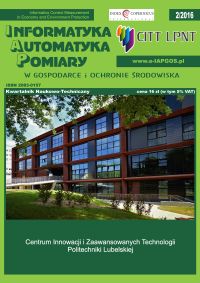SIMULATION OF GRAVITATIONAL SOLIDS FLOW PROCESS AND ITS PARAMETERS ESTIMATION BY THE USE OF ELECTRICAL CAPACITANCE TOMOGRAPHY AND ARTIFICIAL NEURAL NETWORKS
Article Sidebar
Open full text
Issue Vol. 6 No. 2 (2016)
-
TOPOLOGICAL DERIVATIVE METHOD FOR ELECTRICAL IMPEDANCE TOMOGRAPHY PROBLEMS
Andrey Ferreira, Antonio Novotny, Jan Sokołowski4-8
-
MODIFIED ALTERNATIVE DECISION RULE IN THE PRE-CLUSTERING ALGORITHM
Volodymyr Mosorov, Taras Panskyi, Sebastian Biedron9-12
-
IMPROVED MOTION TYPE IDENTIFICATION METHOD USING MOBILE DEVICE SENSORS
Jakub Smołka, Przemysław Troć, Maria Skublewska-Paszkowska, Edyta Łukasik13-18
-
SWIRL FLOW ANALYSIS BASED ON ELECTRICAL CAPACITANCE TOMOGRAPHY
Ayoub Saoud, Volodymyr Mosorov, Krzysztof Grudzień19-23
-
INFORMATICS SYSTEM FOR CONCENTRATION STATE ANALYSIS ON THE BASIS OF A DEVICE OPERATING IN THE BRAIN – COMPUTER INTERFACE TECHNOLOGY
Szczepan Paszkiel24-27
-
DECISION SYSTEM FOR STOCK DATA FORECASTING BASED ON HOPFIELD ARTIFICIAL NEURAL NETWORK
Michał Paluch, Lidia Jackowska-Strumiłło28-33
-
SIMULATION OF GRAVITATIONAL SOLIDS FLOW PROCESS AND ITS PARAMETERS ESTIMATION BY THE USE OF ELECTRICAL CAPACITANCE TOMOGRAPHY AND ARTIFICIAL NEURAL NETWORKS
Hela Garbaa, Lidia Jackowska-Strumiłło, Krzysztof Grudzień, Andrzej Romanowski34-37
-
THEORETICAL ANALYSIS OF GENERATION AND COMPENSATION OF REACTIVE POWER IN PHOTOVOLTAIC POWER PLANTS
Michal Koníček, Boris Cintula38-41
-
LOW POWER DC/DC CONVERTER FROM 3 KV TO 300 V – SIMULATION ANALYSIS
Wojciech Matelski42-47
-
DESIGN AND FEATURES ANALYSIS OF GENERALIZED ELECTRONIC CONTENT-COMMERCE SYSTEMS ARCHITECTURE
Victoria Vysotska, Lyubomyr Chyrun48-59
-
APPROXIMATION OF THE FLUX-CURRENT CHARACTERISTIC OF THE ELECTROMECHANICAL ACTUATOR BASED ON MEASUREMENT RESULTS
Zygmunt Kowalik60-63
-
HOW DO WE DEFINE CYBERCRIME?
Monika Zbrojewska, Volodymyr Mosorov, Sebastian Biedron, Taras Panskyi64-68
-
NOISE MEASUREMENTS AND ENVIRONMENTAL IMPACT ASSESSMENT OF WIND TURBINES
Hanna Pamuła, Maciej Kłaczyński69-74
-
HYBRID ELECTROMAGNETIC LAUNCHER WITH COILGUN AS CURRENT LIMITER IN RAILGUN
Tomasz Makowski75-78
-
ANALYSIS OF THE ELECTRIC FIELD DISTRIBUTION IN THE DRUM SEPARATOR OF DIFFERENT ELECTRODE CONFIGURATION
Mikołaj Skowron, Mikołaj Skowron79-82
-
APPLIED GLONASS OBSERVATIONS IN PPP METHOD IN AIRBORNE TEST IN MIELEC
Kamil Krasuski, Henryk Jafernik83-88
Archives
-
Vol. 8 No. 4
2018-12-16 16
-
Vol. 8 No. 3
2018-09-25 16
-
Vol. 8 No. 2
2018-05-30 18
-
Vol. 8 No. 1
2018-02-28 18
-
Vol. 7 No. 4
2017-12-21 23
-
Vol. 7 No. 3
2017-09-30 24
-
Vol. 7 No. 2
2017-06-30 27
-
Vol. 7 No. 1
2017-03-03 33
-
Vol. 6 No. 4
2016-12-22 16
-
Vol. 6 No. 3
2016-08-08 18
-
Vol. 6 No. 2
2016-05-10 16
-
Vol. 6 No. 1
2016-02-04 16
-
Vol. 5 No. 4
2015-10-28 19
-
Vol. 5 No. 3
2015-09-02 17
-
Vol. 5 No. 2
2015-06-30 15
-
Vol. 5 No. 1
2015-03-31 18
-
Vol. 4 No. 4
2014-12-09 29
-
Vol. 4 No. 3
2014-09-26 22
-
Vol. 4 No. 2
2014-06-18 21
-
Vol. 4 No. 1
2014-03-12 19
Main Article Content
DOI
Authors
Abstract
The paper presents a new approach to monitoring changes of characteristic parameters of gravitational solids flow. Electrical Capacitance Tomography (ECT) is applied for non-invasive process monitoring. Artificial Neural Networks (ANN) are used to estimate important flow parameters knowing the measured capacitances. The proposed approach solves the ECT inverse problem in a direct manner and provides a rapid parameterization of the funnel flow. The simulation of the silo discharging process is performed relying on real flow behaviour obtained from the authors’ previous work. The simulated data are used to new approach testing and verification. The obtained results proved that proposed ANN-based method will allow for on-line gravitational solids flow monitoring.
Keywords:
References
Fiderek P., Wajman R., Kucharski J.: The Fuzzy System for Recognition and Control of the two Phase Gas- Liquid Flows. IAPGOS, 4/2015, 7¬–¬11.
Garbaa H., Jackowska-Strumiłło L., Grudzień K., Romanowski A.: Neural network approach to ECT inverse problem solving for estimation of gravitational solids flow. Proc. of the 2014 Federated Conference on Computer Science and Information Systems (FedCSIS 2014), AAIA’14, Vol. 2, Sep. 7–10, 2014, Warsaw, Poland, 19–26 [DOI:10.15439/2014F368].
Grudzień K., Romanowski A., Aykroyd R.G., Williams R.A., Mosorov V.: Parametric Modelling Algorithms in Electrical Capacitance Tomography for Multiphase Flow Monitoring, IEEE, MEMSTECH'2006, May 2006, Lviv-Polyana, Ukraine, 24–27 [DOI: 10.1109/MEMSTECH.2006.288675].
Haykin S.: Neural Networks: a comprehensive foundation – 2nd ed. Prentice Hall, 1999.
Isaksen Ø.: A review of reconstruction techniques for capacitance tomography. Meas. Sci. Technol. 7/1996, 325–33.
Jackowska-Strumillo L., Sokolowski J., Żochowski A., Henrot A: On Numerical Solution of Shape Inverse Problems. Computational Optimization and Applications 23/2002, 231–255.
Lei J., Liu S.: Dynamic Inversion Approach for Electrical Capacitance Tomography. IEEE Transactions On Instrumentation And Measurement 11/2013, 3035–3049.
Lei J., Liu S., Wang X., Liu Q.: An Image Reconstruction Algorithm for Electrical Capacitance Tomography Based on Robust Principle Component Analysis. Sensors 13/2013, 2076–2092.
Lionheart W.R.B.: Review: Developments in EIT reconstruction algorithms: pitfalls, challenges and recent development. Physiol. Meas. 25/2004, 125–142.
Ratajewicz-Mikolajczak E., Sikora J.: Neural networks method for identification of the objects behind the screen, IEEE Trans Med Imaging 6/2002, 613–619.
Rautenbach C., Mudde R.F., Yang X., Melaaen M.C., Halvorsen B.M.: A comparative study between electrical capacitance tomography and time-resolved X-ray tomography. Flow Measurement and Instrumentation 30/2013, 34–44.
Romanowski A., Grudzień K., Williams R.A.: Analysis and Interpretation of Hopper Behaviour Using ECT. Part. Part. Syst. Charact. 3-4/2006, 297–305.
Smolik W., Radomski D.: The matlab’s toolbox for iterative image reconstruction in electrical capacitance tomography. 5th Int. Symp. on Process tomography (Poland), 98–103.
Stasiak M., Sikora J., Filipowicz S.F., Nita K.: Principal component analysis and artificial neural network approach to electrical impedance tomography problems approximated by multi-region boundary element method. Engineering Analyses with Boundary Elements 31/2007, 713–720.
Warsito W., Fan L.S.: Development of 3-Dimensional Electrical Capacitance Tomography Based on Neural Network Multi-criterion Optimization Image Reconstruction. Proc. of 3rd World Congress on Industrial Process Tomography (Banff) 2003, 942–947.
Article Details
Abstract views: 324
License

This work is licensed under a Creative Commons Attribution-ShareAlike 4.0 International License.






